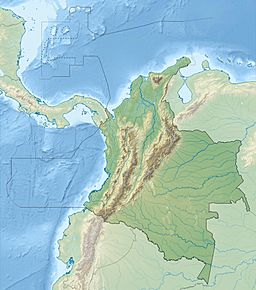Nevado El Cisne facts for kids
Quick facts for kids Nevado El Cisne |
|
|---|---|
| Highest point | |
| Elevation | 4,636 m (15,210 ft) |
| Parent peak | Nevado del Ruiz |
| Listing | Los Nevados National Natural Park |
| Geography | |
| Location | Caldas & Tolima |
| Parent range | Central Ranges Andes |
| Geology | |
| Mountain type | Basaltic lava dome |
| Volcanic belt | North Volcanic Zone Andean Volcanic Belt |
The Nevado El Cisne (which means The Snowy Swan in English) is a fascinating volcano located in the Central Mountains of the Andes in Colombia. It stands tall at about 4,636 meters (15,210 feet) above sea level. This mountain is one of five lava domes that are part of the larger Nevado del Ruiz volcano complex.
Even though its name suggests it's always covered in snow, the top of El Cisne is now often below the permanent snow line. This change is happening because of global warming, which means it's not considered a true "nevado" (snow-capped mountain) anymore.
What is Nevado El Cisne?
Nevado El Cisne is a volcano found in the middle part of the Andes Mountains in Colombia. It's a type of volcano called a lava dome. Imagine thick, sticky lava slowly oozing out of the ground and piling up to form a dome shape. That's how lava domes are made!
This volcano is connected to the much larger Nevado del Ruiz. Think of Nevado del Ruiz as the main parent volcano, and El Cisne is one of its smaller, dome-shaped children.
Why Isn't It Snowy Anymore?
The word "nevado" in Spanish means "snowy" or "snow-capped." For a long time, Nevado El Cisne lived up to its name, with snow and ice on its peak all year round. However, due to global warming, the Earth's temperature is slowly rising. This has caused the snow and glaciers on many mountains, including El Cisne, to melt. Now, you won't always see snow on its summit, which is why it's no longer considered a "true" nevado.
How Was El Cisne Formed?
Nevado El Cisne is built on top of very old rocks that are about 49 million years old. These ancient rocks are cut through by something called the Palestina Fault. A fault is like a giant crack in the Earth's crust where rocks have moved past each other.
The volcano itself is part of the Andean Volcanic Belt, which is a long chain of volcanoes along the Andes Mountains. This area is very active geologically, meaning there's a lot of movement and activity deep within the Earth that helps create volcanoes like El Cisne.
See also
 In Spanish: Paramillo el Cisne para niños
In Spanish: Paramillo el Cisne para niños
- List of volcanoes in Colombia
- List of volcanoes by elevation


